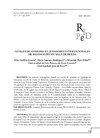Identificador persistente para citar o vincular este elemento:
https://accedacris.ulpgc.es/jspui/handle/10553/7756
| Campo DC | Valor | idioma |
|---|---|---|
| dc.contributor.author | Guillén García, Félix | en_US |
| dc.contributor.author | Santana Rodríguez, Alicia | en_US |
| dc.contributor.author | Bara Filho, Mauricio | en_US |
| dc.date.accessioned | 2012-08-08T04:00:38Z | - |
| dc.date.accessioned | 2018-03-08T13:18:24Z | - |
| dc.date.available | 2012-08-08T04:00:38Z | - |
| dc.date.available | 2018-03-08T13:18:24Z | - |
| dc.date.issued | 2006 | en_US |
| dc.identifier.issn | 1886-8576 | en_US |
| dc.identifier.other | WoS | - |
| dc.identifier.other | Dialnet | - |
| dc.identifier.uri | https://accedacris.ulpgc.es/handle/10553/7756 | - |
| dc.description.abstract | La presente investigación aborda los niveles de ansiedad en jugadores de baloncesto en silla de ruedas de diferentes nacionalidades que participan en alta competición, como la Copa Europa André Vergauwen. El estudio se realizó con una muestra compuesta por 49 jugadores de cinco equipos que participaron en la fase clasificatoria para la fase final, representantes de Inglaterra, Francia, Suiza, Turquía y España y con edades comprendidas entre los 17-50 años. Se les aplicó los cuestionarios SCAT (Sport Competitive Anxiety Test) y CSAI-2 (Competitive State Anxiety Inventory) de Rainer Martens. Los resultados obtenidos muestran unos bajos niveles de ansiedad, tanto en la ansiedad-estado como en la ansiedad-rasgo. Igualmente apenas se han encontrado diferencias entre los jugadores de los distintos países. Las edades y años de experiencia de los deportistas parecen no incidir significativamente sobre la ansiedad en estos atletas. Finalmente, en la ansiedad somática parecen existir ciertas diferencias entre los jugadores turcos y los jugadores franceses e ingleses. | en_US |
| dc.description.abstract | The present research concerns the anxiety levels in wheelchair basketball athletes from different nationalities who participate in high-level competition like André Vergauwen European Cup. The research sample was composed by 49 athletes from five countries (England, France, Switzerland, Turkey and Spain) who participated in the European cup qualifying, age between 17-50 years old. It was applied the questionnaires SCAT (Sport Competitive Anxiety Test) and CSAI-2 (Competitive State Anxiety Inventory) from Rainer Martens. The results showed low levels of trait and state anxiety. Age and years of competition did not show significant influence on athletes anxiety. Finally, somatic anxiety depicts some differences between Turkish players when compared with French and English ones. | en_US |
| dc.format | application/pdf | - |
| dc.language | spa | en_US |
| dc.relation.ispartof | Revista Iberoamericana de Psicologia del Ejercicio y el Deporte | en_US |
| dc.source | Revista Iberoamericana de Psicología del Ejercicio y el Deporte [ISSN 1886-8576], v. 1 (1), p. 69-81, (2006) | en_US |
| dc.subject | 61 Psicología | en_US |
| dc.subject.other | Ansiedad | - |
| dc.subject.other | Baloncesto | - |
| dc.subject.other | Silla de ruedas | - |
| dc.subject.other | SCAT | - |
| dc.subject.other | CSAI-2 | - |
| dc.subject.other | Discapacidad | - |
| dc.subject.other | Deficiencia motora | - |
| dc.subject.other | Anxiety | - |
| dc.subject.other | Basketball | - |
| dc.subject.other | Wheelchair | - |
| dc.title | La ansiedad en jugadores de baloncesto en silla de ruedas de diferentes países | en_US |
| dc.title.alternative | Anxiety levels in International Wheelchair Basketball Players | en_US |
| dc.type | info:eu-repo/semantics/article | en_US |
| dc.type | Article | en_US |
| dc.identifier.isi | 000216455800005 | - |
| dc.identifier.url | http://dialnet.unirioja.es/servlet/articulo?codigo=2245450 | - |
| dc.compliance.driver | 1 | - |
| dc.identifier.absysnet | 537108 | - |
| dc.identifier.crisid | 529;1227;- | - |
| dc.identifier.eissn | 2340-7700 | - |
| dc.description.lastpage | 81 | en_US |
| dc.identifier.issue | 1 | - |
| dc.description.firstpage | 69 | en_US |
| dc.relation.volume | 1 | en_US |
| dc.investigacion | Artes y Humanidades | - |
| dc.rights.accessrights | info:eu-repo/semantics/openAccess | - |
| dc.type2 | Artículo | en_US |
| dc.contributor.daisngid | 2152134 | - |
| dc.contributor.daisngid | 6474544 | - |
| dc.contributor.daisngid | 2539081 | - |
| dc.identifier.external | 529;1227;- | - |
| dc.contributor.authordialnetid | 53165 | - |
| dc.contributor.authordialnetid | 1967789 | - |
| dc.contributor.authordialnetid | No ID | - |
| dc.identifier.dialnet | 2245450ARTREV | - |
| dc.description.numberofpages | 13 | en_US |
| dc.utils.revision | No | - |
| dc.contributor.wosstandard | WOS:Garcia, FG | - |
| dc.contributor.wosstandard | WOS:Rodriguez, AS | - |
| dc.contributor.wosstandard | WOS:Bara, M | - |
| dc.date.coverdate | 2006 | en_US |
| dc.identifier.supplement | 529;1227;- | - |
| dc.identifier.supplement | 529;1227;- | - |
| dc.identifier.supplement | 529;1227;- | - |
| dc.identifier.ulpgc | Sí | - |
| dc.description.sellofecyt | Sello FECYT | |
| dc.description.esci | ESCI | |
| dc.description.erihplus | ERIH PLUS | |
| item.fulltext | Con texto completo | - |
| item.grantfulltext | open | - |
| crisitem.author.dept | Departamento de Educación Física | - |
| crisitem.author.orcid | 0000-0002-1543-1351 | - |
| crisitem.author.fullName | Guillén García, Félix | - |
| crisitem.author.fullName | Santana Rodríguez, Alicia | - |
| Colección: | Rev. Iberoam. psicol. ejerc. deporte. 2006. v.1, n.1 Artículos | |
Visitas
180
actualizado el 16-sep-2023
Descargas
134
actualizado el 16-sep-2023
Google ScholarTM
Verifica
Comparte
Exporta metadatos
Los elementos en ULPGC accedaCRIS están protegidos por derechos de autor con todos los derechos reservados, a menos que se indique lo contrario.
